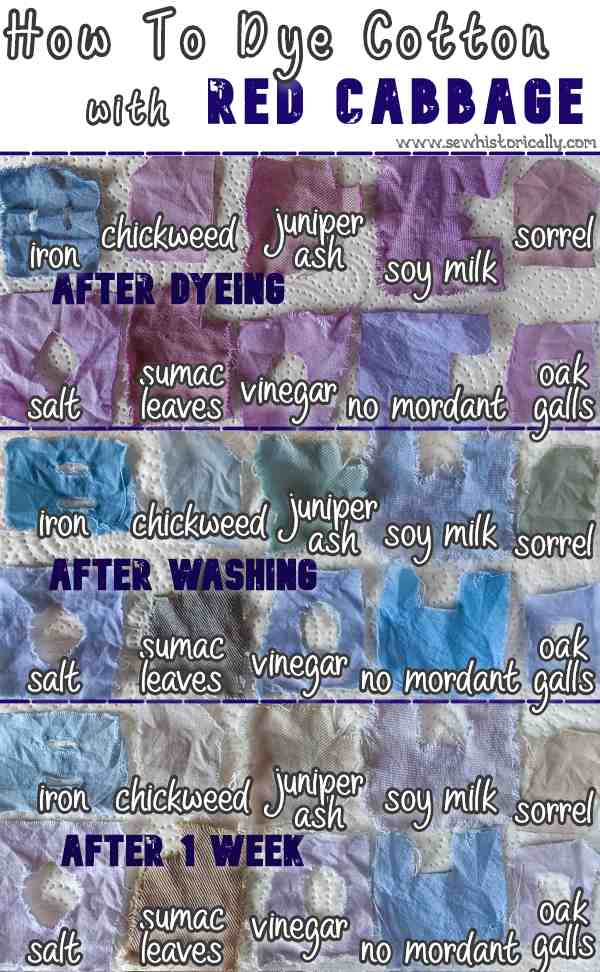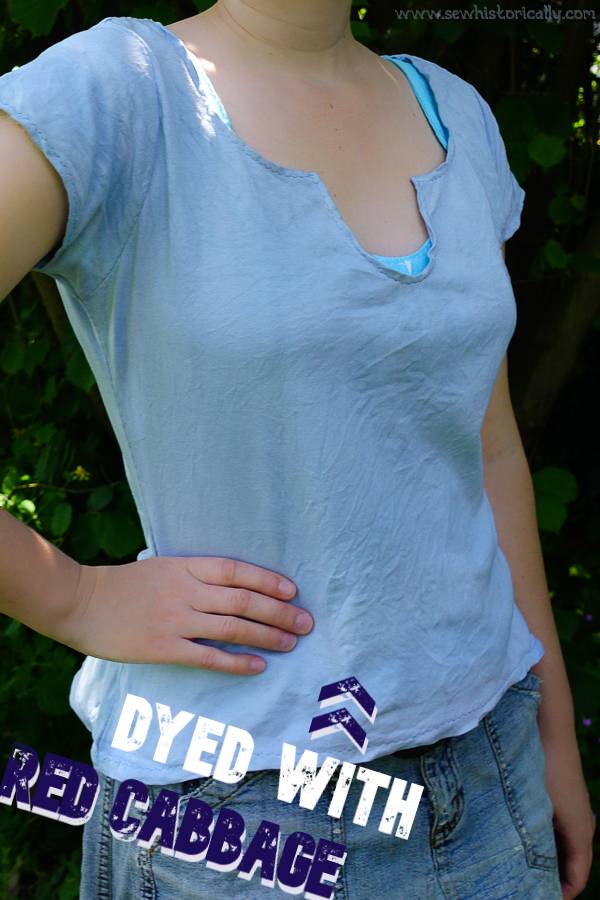I’ve written up a follow-up to my tutorial on how to dye cotton blue with red cabbage because it’s one of the most popular posts on my blog! 😀
Related: How To Dye Blue With Red Cabbage (DIY Iron Mordant)
This is a little different to my first tutorial because here I’m extracting the red cabbage dye with more heat and you you don’t even need a mordant to dye cotton fabric blue! Like my other method of dyeing cotton blue (cold method with DIY iron liquor), this method also dyes a lightfast and washfast blue on cotton fabric!
Blue, turquoise and other shades of blue are my favorite colors but shades of blue are difficult to dye with natural dyes – particularly on cotton! Apart from indigo and woad, red cabbage is the only natural blue dye that worked for me so far! And over the years I’ve tried a lot of different plants I’ve read about on the internet and in books that are supposed to dye blue – like cornflowers, lupine flowers, blueberries, elderberries, sloes … – but they didn’t work – at least not for me! 😉 But you can easily dye a beautiful lightfast and washfast blue on cotton even without a mordant! Yay! 😀 Red cabbage is my favorite natural blue dye because you can also use it to dye Easter eggs or your food blue!

How To Dye Cotton Blue With Red Cabbage (No Mordant)
You’ll Need:
- red cabbage
- pre-washed cotton fabric, cotton yarn or cotton clothing
- pot
- maybe: vinegar or baking soda
1. Extract the red cabbage dye
Chop the red cabbage into small strips. Then put the red cabbage strips into a pot. You can use a cooking pot because this red cabbage dye is edible but you can also use a separate dye pot. Now add water so that the red cabbage is covered with water. Then let the red cabbage soak overnight in water. I used about a 3/4 head of red cabbage to dye 4 cotton tank tops. By the way, the red cabbage I used was no longer suitable for eating because one side of the red cabbage was moldy. I cut off the moldy side and used the rest of the red cabbage head: And it still produced a beautiful natural blue dye! 😀
On the next day, heat the red cabbage dye solution a little: Make sure that the temperature stays below 70°C (160°F) because natural blue dye is heat-sensitive! Then turn off the heat and let the red cabbage soak a little longer. You can heat the dye pot from time to time to below 70°C (160°F) and then let it soak again at room temperature. Repeat this until the red cabbage strips turn pale and the water is dark blue, purple or pink. This usually takes between a couple of hours and two days depending on how often you heat the dye solution up to 70°C (160°F). My red cabbage dye solution took about 36 hours until it was ready for dyeing.
2. Remove the red cabbage
Now remove the red cabbage strips.
Related: How To Dye Cotton With Black Beans (No Mordant Needed)
3. Adjust the ph
Adjust the ph to around 5 if necessary -> see FAQs. If the red cabbage dye solution is too acidic during the dyeing process (ph 3 instead of ph 5) then the color of the fabric washes right out during the first wash. And if the red cabbage dye solution is too basic during the dyeing process then the dyed fabric isn’t very lightfast. The fabric fades to light blue or even back to white after a couple of days or weeks. So adjust the pr to around 5 to produce a washfast and lightfast blue.

4. Dye the fabric
Add the piece of cotton clothing, cotton fabric or cotton yarn you want to dye. Make sure that it’s fully submerged and that there are no air bubbles.
You can either let the cotton fabric soak at room temperature in the red cabbage dye or heat the dye pot from time to time to below 70°C (160°F). If you’re going to dye your fabric for more than one day, it’s better to heat the dye solution with the fabric in it up to 70°C (160°F) at least once a day to prevent bacteria and mold growth.
Related: How To Dye Cotton Green With Red Hazelnut Leaves (No Mordant Needed)
It can also be necessary to re-adjust the ph during the dyeing process. The fabric should always be purple during dyeing: If it turns pink add baking soda, if it turns blue add vinegar. Add a little at a time (about 1/4 teaspoon baking soda or 1 teaspoon vinegar), stir and wait about a minute. Then add more if necessary.
Remove the fabric from the dye as soon as you like the color. Keep in mind that the color of wet fabric appears darker then that of dried fabric. The color will still be purple, it will turn to blue later!
5. Let the fabric dry
Let the fabric dry completely. If you wash the fabric immediately after dyeing, the color will not be as deep as if you let the fabric dry before washing.
6. Wash the fabric
Wash the red cabbage dyed fabric in warm water and soap (or in the washing machine). During washing the purple fabric will turn to blue! 😀 After washing, let the fabric dry in the shade.
Please Pin It!
